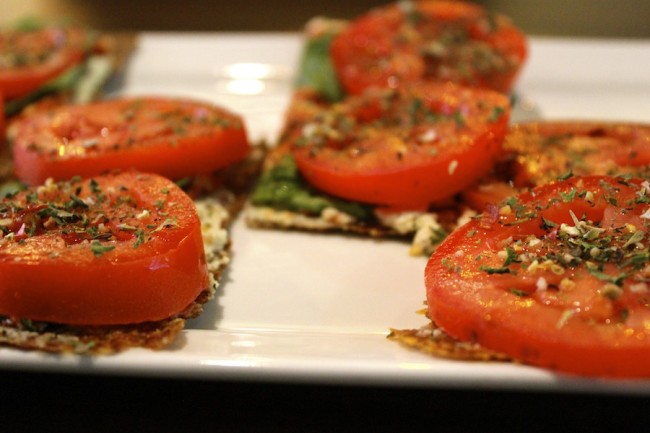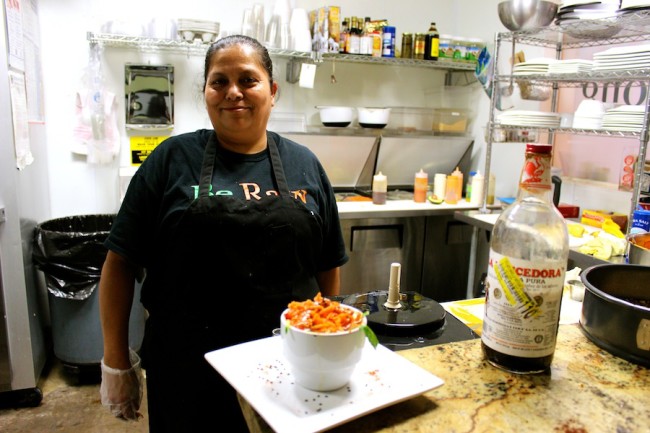
Walk through the cozy dining room of the Dallas restaurant Be Raw and you’ll pass right by the tiny kitchen in about three steps. There’s no oven, and there’s no stove.
The kitchen isn’t equipped for traditional ways of cooking. But even with only a refrigerator, a dehydrator and a Vitamix blender, Be Raw still offers a full menu of popular dishes including pizza, pasta, enchiladas and sandwiches.
Everything here is made from completely raw, 100 percent vegan ingredients, meaning that nothing is cooked and nothing contains any meat, dairy or eggs. There’s even a raw cheesecake.
More people today are becoming aware of the raw vegan diet and some are choosing to quit meat, dairy, eggs and cooked food cold turkey. Raw veganism is developing into a lifestyle trend that is catching on in Dallas and other cities.
“There is more and more of an awareness of what it takes to be healthy, and that food is really the basis for it, that you need healthy food to be healthy,” said Paula Sepulvado, owner of Be Raw at The Plaza at Preston Center. “You can’t eat junk food and have health.”
A purely raw vegan diet consists of raw fruits, vegetables, nuts, seeds and healthy fats like olive and coconut oil. But even with so few ingredients to work with, raw vegans still manage to invent a lot of options beyond a leafy salad.
Amy Jo Hearron is a local personal chef who specializes in cooking – or, not cooking – elaborate raw vegan, paleo and allergy-friendly dishes for her clients.
“My main focus for my clients is that there are plenty of alternatives and replacements for whatever we cut out,” Hearron said. One of her most popular dishes is a raw chocolate pie made with avocado and coconut oil, an adaptation of a recipe that typically calls for milk and eggs as key ingredients.
Creating raw vegan dishes is both an art and a science. Sepulvado said that she tends to keep her meals simple at home, but raw recipes that take time work well for the restaurant.
For example, Sepulvado’s most popular dish is the kale and coconut enchiladas. The recipe starts with 10 cases of coconuts. The kitchen staff must first crack each and every coconut by hand. Then they blend the coconut meat together with a few other ingredients before pouring the mixture onto trays that are placed into the dehydrator for 10 to 12 hours. A dehydrator works by using low temperatures below 115 degrees to dry food while keeping the live enzymes intact, an idea that is at the heart of the raw vegan diet philosophy.
Sepulvado said that the nutrients and digestive enzymes in food are killed when food is heated at temperatures above 115 degrees. At that point, raw vegans believe that food becomes significantly less nutrient-dense and more difficult for the human body to digest.
But while raw vegans passionately believe that food in its most pure and unaltered state offers the greatest health benefits, some experts question how significant a plant’s enzymes really are compared to the powerful digestive acids naturally found in the human stomach.
“There are so many enzymes that are present in the gut to handle just about anything,” said Meridan Zerner, a registered dietician at Dallas’ Cooper Clinic. “I would be hard pressed to find something that much stronger than the acids in the human stomach.”
Zerner also pointed out that some foods, like tomatoes, are actually more nutrient dense when cooked.
There are some important nutrients missing from a raw vegan diet because they are found only in meat, including vitamin B12, iron and folic acid. Most vegans and vegetarians must supplement to avoid deficiencies and potential side effects, Zerner said.
“We are fully equipped with all the digestive enzymes to eat and process animal proteins,” Zerner said. “The raw vegan diet is in subtle defiance of the definition of omnivores.”
While Zerner does acknowledge that many Americans eat too much protein, she said that we are not designed to eat raw food only.
Regardless of whether it’s raw foods or cooked foods that offer the most nutrients, most health and diet experts agree that everyone could benefit from eating more fruits and vegetables.
“We are a nutrient-deprived culture right now,” said Kim Wilson Pollock, a holistic health coach certified through the online Institute for Integrative Nutrition and a former raw vegan.
Pollock believes that there is no perfect diet for everyone, and that people need to be aware of how their bodies feel on any diet.
Both Pollock and Zerner said that a plant-based diet, even one that is not raw vegan, is widely considered to be the healthiest.
“The more people who realize they need fresh food for health and incorporate that into their diet, the more healthy they’re going to be,” said Sepulvado.
Some raw vegans modify the diet to fit their own needs. For purists, this means a completely raw food diet. For others, like Hearron, it might mean the occasional piece of meat or fish, certain cooked foods or a recipe that calls for eggs.
Hearron is not a textbook raw vegan. For the past eight and a half years she has followed a blend of the paleo diet philosophy and the raw vegan mantra. About 85 percent of what she eats is raw vegan, but she also eats the occasional piece of fish or chicken, in accordance with the paleo diet, which focuses on animal proteins. Her clients are either strictly raw vegan, strictly paleo or take a similar integrated approach as hers.
Jennifer Smith, a senior at SMU, said that she has thought a lot about going fully raw, but a lack of time and resources prevents her from making the leap.
A vegan since October 2010, Smith still eats cooked foods, including pasta and grains, but she never feels tempted to eat meat. Occasionally she will eat eggs, but only if she has personally visited the farm to determine for herself if the chickens producing the eggs are humanely raised and allowed adequate freedom to roam.
“I don’t think veganism is black and white, I think there’s a lot of grey areas,” said Smith.
Within days of going on a mostly raw diet, Hearron said that she noticed changes in her body including better skin, improved concentration, elevated energy and even clearer vision.
“All of my five senses heightened,” she said.
In fact, almost any raw vegan will say that they feel more energetic after going on the diet. Pollock even said she believes that the number one benefit of the raw vegan diet is endless energy.
Fruits and vegetables are easy to digest and leave a person feeling light and energetic, according to Pollock. She said that as long as people eat a large enough quantity of raw foods, they can receive enough nutrients to function at optimum level.
Zerner, on the other hand, said that there is no scientific evidence to support the claim that a raw vegan diet gives people more energy.
“It’s what everybody uses as a conclusion,” she said. She pointed out that the general feeling of increased energy is vague and can be defined differently depending on the individual. There is no way to test energy levels, and many other factors including sleep, fitness level and hydration can all affect energy.
Zerner said that while she also sees a lot of benefits to the raw vegan diet, it requires a strong intention and a lot of planning to do it in a way that works for the human body. She said that most registered dieticians are fully capable and willing to work with people who choose to eat a raw vegan diet to help them achieve the best results.
“Any effort to add more color into the patient’s diet is probably worthy, but I have to re-emphasize that good health is more easily and more frequently found in the middle ground,” Zerner said.
Mallory Ashcraft is a junior at SMU majoring in advertising with a minor in journalism. She is also the food editor for the SMU student-produced newspaper, The Daily Campus. She may be reached at [email protected].












